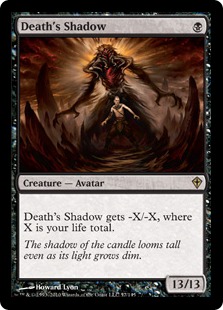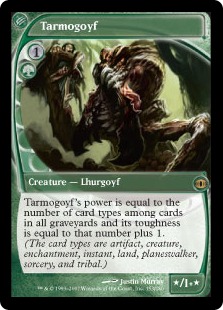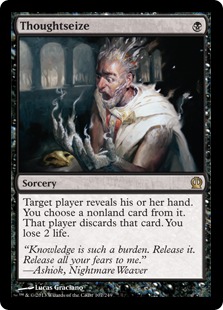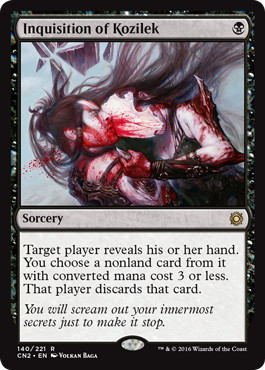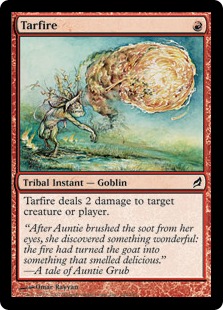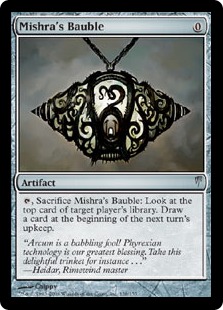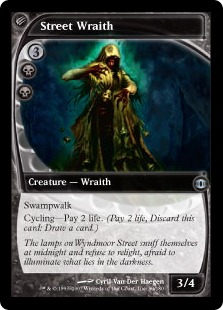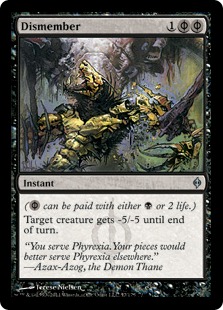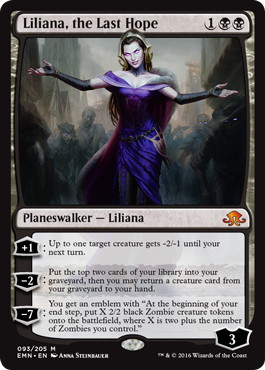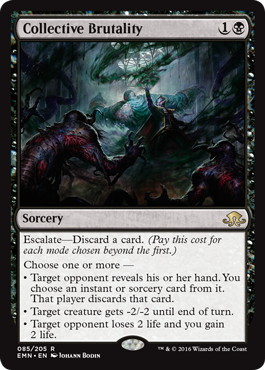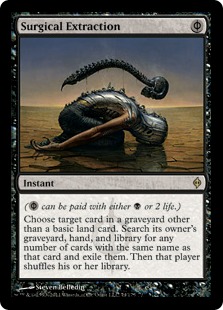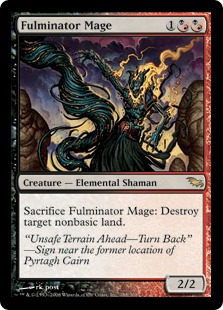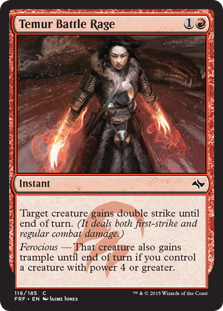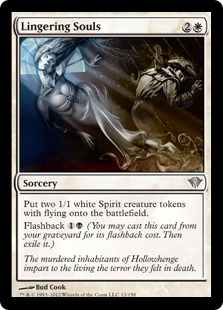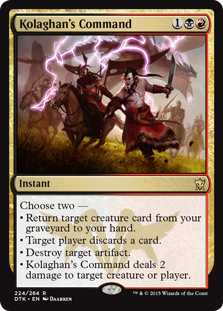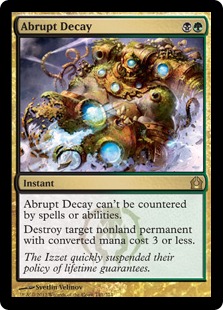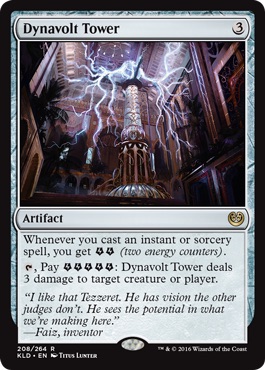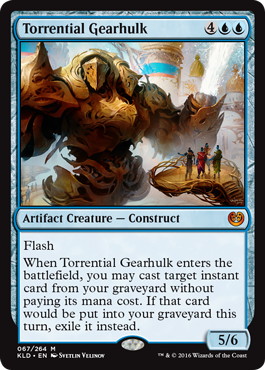Hello and welcome back to a new article. Not a lot of time passed since I wrote my article and if you read [the last one] you are probably aware that I was playing the Modern Grand Prix in Vancouver. I did not post my latest list because I did to not want to give away too much information before the tournament, as I had a great feeling about the deck I was playing.
Evolution in Modern: Death’s Shadow Jund
I was playing Death’s Shadow Jund, basically the same deck that won the GP and placed another 2 players in the Top4 of that tournament. This result is pretty amazing for a format that is not fully explored yet, especially considering the low number of players that ran the deck. For my own part I finished 11-4, which is not an amazing result, but was good enough for some cash and 2 Pro Points, which felt well deserved after I had a great match against Alexander Hayne in the last round to secure my Points.
I did not have any information about the lists the American players were playing, but they eventually ended looking about the same as my list. So let’s have a look at the list I was playing:
Oliver Polak-Rottmann “Death’s Shadow Jund”
GP Vancouver
1
1
2
1
1
1
4
4
2
1
-Lands (18)-
4
4
4
-Creatures (12)- |
4
4
4
3
3
3
1
2
1
4
1
-Spells (30)- |
4
2
2
2
2
1
1
1
-Sideboards (15)- |
So let us talk a little bit about the evolution of the deck. The Death’s Shadow Aggro, or as formerly called: Suicide Zoo, ran a lot of creatures, including and , with pump and free spells in the form of , and . was too slow for the old deck and also was not working too good with , as your main gameplan was to Combo-Kill your opponent with . The deck had quite a lot of success and was considered one of the best decks in the format before the bans. At the end of the old season some Germans, including former Pro Tour Champion Simon Gortzen, were tinkering on a slower, grindier version of the deck, which had almost qualified Simon for another PT, unfortunately he was short on tiebreakers, but that was the first time I saw a list that was pretty close to what we are cooking with today.
With the bans had to leave the format, which was one of the most powerful cards in the deck and none was sure if could exist without the essential free spell. This past weekend showed that it is certainly possible, you just have to adapt your gameplan a little bit and accept that you will not kill on turn 2 anymore.
Before we go into details with the current list, possible changes and sideboard plans I want to give two Austrian countrymen Mark Muhlbock and Gold Level Pro Immanuel Gerschenson credit for convincing me that this deck is the best in the current format and for their time helping me with the list.
So we have two different strategies combined in one deck, shocking ourselves to power out a shockingly big or achieve Delirium to get online or smash with huge s. I currently do not run other creatures in the maindeck, but adding 1 , which acts as an additional that you can tutor for, or 1 for some more value lategame is very possible. Yes, I do run , but it hardly counts as creature, as you will not cast it often. Tutoring it up to shock yourself more came up for me several times during the tournament, so keep this in mind.
On top of our two winning strategies, we run the usual Jund package with discard and removal. With 7 1-Mana discard spells you run more than any other deck in the format, but this is important as you need to know that the coast is clear and it helps you set up your gameplan properly. Besides that you hardly ever play anything else for one mana on your first turn. Which might seem a little out of place is . I am still not sure how good or bad this card is in Modern, but it seems it is needed. It helps you a lot with Delirium, as Tribal counts here, and it pumps our , which is especially relevant when you have . So we try to dirsupt our opponent, while we are damaging our own life total and fill up our graveyard. Sounds complicated and it is as challenging as it sounds, especially your first one or two turns are crucial to a successful game.
Let me give you some gameplay tips, in case you have never played this kind of strategy: First and most important are the tricks with ! First decision is whether we want to check our own library or our opponent. Usually we might think that knowing what your opponent draws is more important, but with this deck it is different, as we have and a lot of shuffle effects. So when you have you always want to optimize your own draw, which means you check your library, if you like the card you either cycle or draw the card with Bauble. If you don’t like it, just crack a Fetchland and the card is gone and you get something fresh. The second thing with bauble is, that you should always bauble your opponent in their upkeep, this way you do see the same card, but protect yourself from opposing discard spells.
It is important to keep track of your and your opponents lifetotal all the time, as one point of life is even more crucial then in an usual game of Magic, never miss out on a card in your graveyard if you have , always count how your opponent could kill you if you have . You also have , which speeds you up by one turn and can kill through opposing blockers, as getting ferocious is no challenge with this deck.
There are several cards that could be played in your maindeck 60 Cards, for now I would change 1 for a and 1 for a second . But you could also run 1 , which has a pretty unique effect. I liked the 1 a lot, and wish there would be a space in the sideboard for a second copy, as it reliably kills the Eldrazi and , which are hard to deal with with only and . In the sideboard I would remove the and add a , it is just better.
Sideboarding Guide
I want to give you a brief Sideboard Guide for the most relevant matchups. I am still not sure what the bad or worst matchups are to the sideboard may need some changes. to reflect this.
This might just be the worst matchup, and even here it is about how the draws match each other. They have no maindeck solution for our , so they are under the gun as soon as he hits play. is also decent, slower though. Having an additional would increase your chances of winnig by a lot, this certainly is your best card in the matchup and you could use some more cards. In postboard games be aware that they have , so always try to hit them with or before you go for the kill.
That is a tricky one, but I think you should be fine in this matchup, just make sure that a does not kill you out of nowhere. I am not sure if is great there, but the other cards are stricly worse.
That is basically a Mirror-Match, you just have bigger creatures, so the agenda is to kill their and try to stick a creature with the help of discard. , and are your trump cards for this matchup.
I think it correct to try to be as aggressive as possible in this matchup and therefore just board as above.
This plays out very different than the BG matchup, it is very interactive and his threats are harder to kill than what Jund brings to the table.
Evolution in Standard: Temur Dynavolt Tower
There was also a Standard GP in Utrecht last weekend and the metagame and decks changed quite a bit. Mardu did win again, but the list looks significantly different than the PT winning decklist with Maindeck and a lot of Planeswalkers and Oaths to board into a decent “control” deck.
Talking about control, that is what I played once again. Before the tournament I only knew that I wanted to play and along with no clue what other colors should be in the deck. Fortunately Master Shota Yasooka played a Magic Online League 5-0 with Temur Tower, and if he plays a deck the world knows about it. I checked out his decklist, changed a few things and registered this list, which carried me to a 12-3 record and 20th place finish:
Oliver Polak-Rottmann “Temur Dynavolt Tower”
GP Utrecht
5
1
1
4
4
4
2
-Lands (21)-
3
4
3
-Creatures (11)- |
4
1
4
3
2
2
1
2
1
4
1
4
-Spells (28)- |
3
2
2
2
2
2
1
1
-Sideboards (15)- |
Basically the deck is only Blue-Red with a small splash of Green. But this makes the difference, as works like a along the and decreases the number of lands in your deck. 21 might still be one to few, but that could easily fixed, as there is a card in the deck which does not belong there: . It was so disappointing for me that I just boarded all of them out in almost every matchup. Right now I would change all 4 for 1 , 1 , 1 and another card, which could be a . Besides that I would swap the for a third and the s for .
The deck was very popular among the pros and I am not entirely sure how it fares against Mardu-Ballista, but I assume it should be fine. This might be the final version of the Tower-Deck people were looking for so long, at least it pushed itself into the Metagame and extended the Top 3 Decks (Mardu, BG and Saheeli) to a Top 4.
My next tournament will be Grand Prix New Jersey and I am almost certain I will run a Tower list again, maybe I can find the time to test a few games, if not I will most likely run the updates I posted above. Best of luck to everyone and have fun until you hear from me again.
Oliver
Cards found in the Article
 Oliver Polak-Rottmann
Oliver Polak-Rottmann
A powerhouse player who was the Champion of GP Utrecht 2014 with Mono-Blue Devotion and another 4 GP Top 8’s to his name and countless Pro Tour appearances.
Always on the forefront of reading the Standard metagame of any given season, he continues to travel and find success at events all over the world.
More by Oliver Polak-Rottmann











